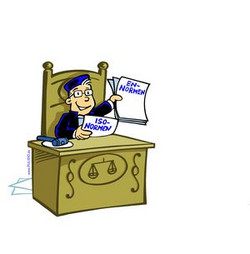KANBrief 4/16

Which parts of standards and similar documents are referred to in court rulings, and for what reasons, was the subject of a legal report (pdf, in german) produced on behalf of KAN and published in december 2016 (Project partner: Professor Dr Thomas Wilrich (lawyer). One finding of the report was that the terms "normative" and "informative", which are precisely defined in the rules and structures of standardization (Particularly DIN 820-2, Standardization – Part 2: Presentation of documents; CEN/CENELEC Internal Regulations – Part 3:2011 (ISO/IEC-Directives – Part 2:2011, modified)), have a somewhat different meaning in court rulings.
The study analysed 68 court rulings, in German and meaningful to the work of KAN, in which standards or similar documents played a significant part. The essential legal significance of standards was not the issue. Rather, the task was to examine, for each ruling:
In the majority of rulings, the relevance of the standards referred to is not discussed. Rulings often state only the number of the standard and do not cite content from it. In some cases, it is not even explicitly stated which standard is being referred to.
Occasional reference is made in the rulings to informative content, but never with conscious discussion of what constitutes "informative". The requirements contained in a standard or similar document the satisfaction of which is essential for fulfilment of the document's purpose must be contained entirely within the document's normative parts. At the same time, informative parts such as annexes or national forewords may be of major importance, since they indicate for example the extent to which a document gives rise to a presumption of conformity in the context of a certain legal regulation, or the document's relationship to state occupational safety and health regulations.
By contrast, courts are primarily concerned with the use of statements found in standards and similar documents, irrespective of whether these statements are normative or informative in nature, to underpin conclusions drawn from the legislation. Ultimately, it can be said that from the perspective of a court, all parts of a standard are "informative", in contrast to the "legally normative" statements of legal provisions, which alone are binding (In legal disputes concerning the fulfilment of a contract requiring compliance with a standard, however, only normative parts of the text are likely to be relevant).
The role of the stakeholders involved in standardization was discussed somewhat more often – but in all cases more for confirmation of the conclusion already reached, never as substantial grounds. In 1991 for example, the Lüneburg Higher Administrative Court praised the responsible working committee for the professional breadth and balance of its composition, and even made specific reference to the stakeholders represented on it. Conversely, the Federal Administrative Court submitted in 1987 that the standards committees "also include representatives of certain sectors and companies who present the viewpoints consistent with the latter's interests. In the event of a dispute, the results of their deliberations should not therefore be regarded uncritically as 'established expertise' or as pure research results".
The rulings contain copious statements concerning the suitability of the standards referred to. Again, two examples follow. The Federal Administrative Court also emphasized in its 1987 ruling: "DIN standards committees are comprised such as to possess the expertise required for their task". The Cologne Higher Regional Court stated in 2008: The "provisions" of the DVGW "professional federation" "are highly respected and (much like DIN standards) are regarded as a written formulation of recognized good construction practice, provided nothing to the contrary is established by experts".
The courts' arguments contain no systematic definition of the suitability of the standards referred to. The standards serve to support the result already reached by other means, and thus as an additional justification for the ruling.
Increasing mutual understanding
Overall, court rulings are seen not always to follow the system of the composition and work of the committees and the constituent parts of the standards as set out in the rules governing standardization. In the interests of ease of use and legal clarity, it would be highly desirable for standards developers and legal practitioners to be more aware of their different respective interpretations of the terms "informative" and "normative".
Prof. Dr. Thomas Wilrich
wilrich@hm.edu
Corrado Mattiuzzo
mattiuzzo@kan.de